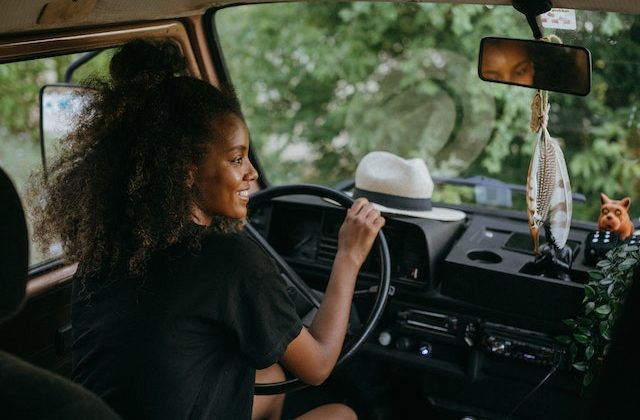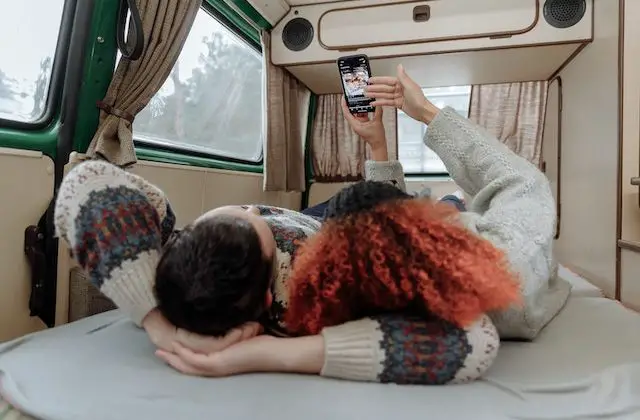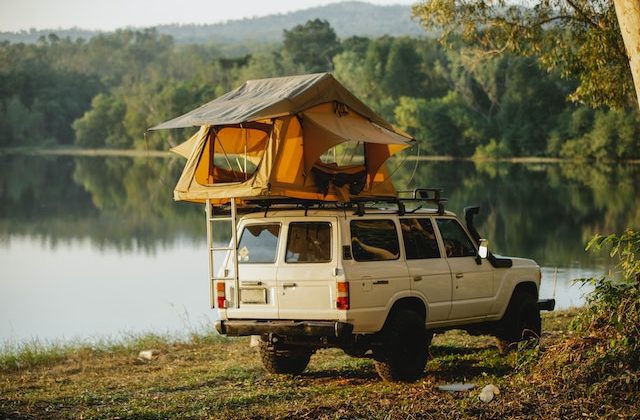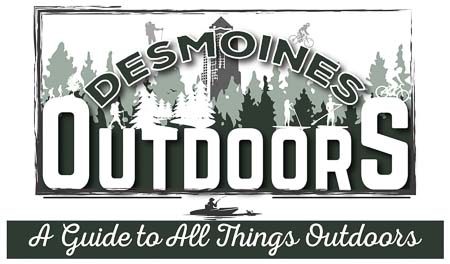This article contains affiliate links. In other words, if you click on an affiliate link and buy a product, this blog may receive compensation at no cost to you. See our full disclosure here.

Car camping is a cheap and simple way to travel! So, if you don’t have a tent, or even if you do, car camping is an excellent option for any road trip.
And since it’s more popular than ever, it’s easy to find the car camping gear to make your experience comfortable and easy.
So, if you’re interested in learning more, read on. Below, we discuss the ins and outs of car camping, how to prepare, and what you need to get started!
Table of Contents
Related:
• Camping Checklist [+ PDF]
• Easy Camping Food: 10 Simple No-Stress Camping Recipes
• Camping Essentials for Women: 5 Necessities For Your Camping Adventure
What is car camping?
Car camping means sleeping in your car. But it’s more than just pulling off the road and snoozing. It’s a fun and inexpensive way to take adventurous road trips!
The good news is, with the popularity of car camping on the rise, there’s more information – and more gear – to get you started.
Yet, to make the most of your car camping experience, we recommend you do some research first.
Read about how others do it, do a trial run, and see what items to pack to make car camping more manageable and comfortable. And before you hit the road, plan out trip details, especially your route and where to camp.

How to go car camping
1. Evaluate your car camping setup.
The first thing to consider is your vehicle. Do you have a sedan, SUV, van, or truck? Some cars are better suited for car camping than others.
The type of car determines your most basic camping needs – especially your sleeping arrangements. It’s possible to create sleeping quarters in a sedan, but a larger vehicle makes it easier. Of course, you can always pack a small tent if your car is too small to sleep in.
Figure out how to set up your vehicle to sleep comfortably – and pack the gear you need. Consider camping essentials in this article to make your experience convenient and cozy.
2. Get the gear you need.
Once you consider how to sleep in your vehicle, get the essentials.
Some specific car camping gear makes creating a bed in your car easy.
This might include a sleeping bag, air mattress, sleeping pad, and pillows.
Consider other things that add or detract from your comfort, like airflow, lighting, organization, and safety. And remember to consider how to keep your devices charged up.
You might also need a good quality cooler, cookstove, and mess kit if you plan to cook. Depending on where you plan to camp, water storage is a necessity.
3. Do a trial run (or two or three).
Start by setting up your car for camping while at home. Check for comfort, see how everything fits, and decide what you need – or what to leave behind.
Next, try a night of camping close to home. Camp for 24 hours to simulate what it will be like once you hit the road. Since you’re close to home, if you’re super uncomfortable or forget something essential, you can work it out more easily.
Also, take a weekend trip further from home to work out kinks before heading out on a long road trip.
4. Research places to camp.
Once you’ve got a good setup, it’s tempting to take off and go wherever the road takes you. But it’s wise to have a plan, especially at first.
At the very least, figure out where you will camp. Of course, campgrounds are the easiest and often have amenities you want – like showers and even electricity. But you might consider other camping options, like parking lots, BLM land, and rest stops (or friends’ driveways!).
Just remember, local laws can restrict where you stay. For example, Walmart and Cracker Barrel often allow overnight car campers. But local laws sometimes prohibit this. Also, some individual stores don’t allow camping, and others require you to get permission.
A good resource for informal or wild camping is ioverlander.com. Here, folx report their experiences with informal camping in specific locations.
5. Have fun!
You can’t consider car camping anything but an adventure! It’s a fun and inexpensive way to explore parks and trails and travel to fun destinations. Going into it with an adventurous spirit is an excellent way to create lasting memories.

Car camping essentials
What you need for car camping depends on
- your vehicle,
- where you camp,
- how you camp, and
- how long and often you camp.
No matter how you decide to go car camping, you’ll need some basic things. Below are the car camping essentials, with questions to consider before you head out.
Sleep setup
Where and how will you sleep?
Consider how to sleep comfortably in your car. You might just need a sleeping bag. But some folx prefer an air mattress or sleeping pad for a little extra cushion. They even make mattresses designed for car camping! (And remember a pillow!)
Do you need a small tent?
Consider a small, easy-to-set-up tent if you can’t make your car work for sleeping. Manufacturers even make tents with car campers in mind – some attach directly to your vehicle!
How will you regulate sleep temps?
Think about nighttime temperatures where you plan to camp. How can you keep your car’s temperature comfortable? Of course, you might crack the windows. But you might also consider a fan or screens that fit your windows.
Will you need window shades?
Consider car shades to block the sun and light from your car windows.
Food & water
How will you eat and drink? Will you provide most of your own food or buy it as you travel?
At a minimum, you should have extra water and snacks with you. And if you’re camping in a remote location, you’ll need extra food and water – and places to store them.
How will you store food?
It’s a good idea to have a cooler for storing food. The size you need depends on how much food you want or need. You can also use a sealed tote for shelf-stable food.
Do you need water storage?
It’s a good idea to have extra water wherever you’re camping. An extra gallon might be enough if you have a water source or can buy it nearby. But if you camp far from water sources, in places like BLM land, you must have a way to store water.
Will you cook your own food?
Consider a camp stove and mess kit for cooking without a campfire. If you have a campsite with a fire pit, you can take a skillet or pot to cook over the fire. And, if you do cook, you probably want a multi-functional tub and washcloth for washing dishes.
Lighting and devices
How will you see inside and outside of your car at night?
You could use a flashlight, headlamp, or lantern. Or all three for different needs.
Do you have a way to charge your devices?
Can you charge your devices even when your car isn’t running? It’s a good idea to have an extra power bank. Consider a solar power bank so you don’t have to worry about battery life.
Will you have Wi-Fi available?
Consider a hotspot if you camp in areas without Wi-Fi. And if you’re traveling and camping in remote locations, you might get a handheld GPS.
Personal care items
Will you have access to showers?
If you’re camping in a place with public showers, you only need soap and a towel. But if no showers are available, consider how you will stay clean. Take a portable outdoor shower & tent, dry shampoo, and wipes when showers are unavailable.
What personal hygiene items do you need?
Make a list of the essential personal hygiene items you need. Think about your car camping routine. Do you need waterless options? Pack dry shampoo, shower wipes, etc., to use between showers. Store your items so they’re compact yet accessible.
Other
- How will you organize your items? Consider compact, lightweight storage.
- How will you pack and store clothing? Packing cubes work great.
- Do you need a chair or hammock? Portable and foldable are the features you want here.
- Do you need shelter from the rain and sun? Some options attach to your car.
- Do you need extra cargo capacity? Consider roof or hitch storage.
- Don’t forget other required items, like sunscreen, bug spray, tarps, rope, etc.
Next:
- Camping Essentials for Women: Five Necessities For Your Adventure
- Camping Checklist [+ PDF]
- Camping Gear for Dogs: Best gear for your dog’s safety & comfort
